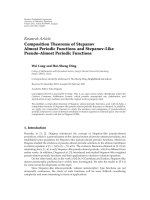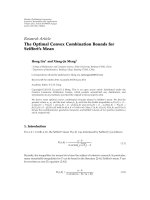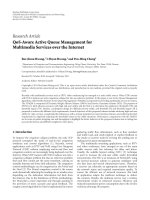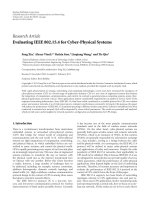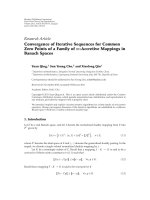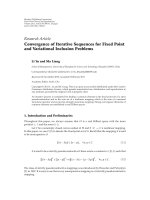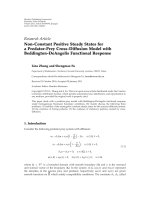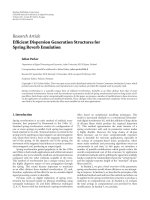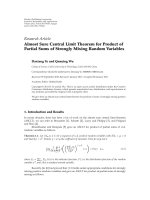Báo cáo hóa học: " Research Article Convergence Theorems Concerning Hybrid Methods for Strict Pseudocontractions and Systems of Equilibrium Problems" pot
Bạn đang xem bản rút gọn của tài liệu. Xem và tải ngay bản đầy đủ của tài liệu tại đây (515.68 KB, 14 trang )
Hindawi Publishing Corporation
Journal of Inequalities and Applications
Volume 2010, Article ID 396080, 14 pages
doi:10.1155/2010/396080
Research Article
Convergence Theorems Concerning Hybrid
Methods for Strict Pseudocontractions and
Systems of Equilibrium Problems
Peichao Duan
College of Science, Civil Aviation University of China, Tianjin 300300, China
Correspondence should be addressed to Peichao Duan,
Received 23 May 2010; Revised 23 August 2010; Accepted 26 August 2010
Academic Editor: S. Reich
Copyright q 2010 Peichao Duan. This is an open access article distributed under the Creative
Commons Attribution License, which permits unrestricted use, distribution, and reproduction in
any medium, provided the original work is properly cited.
Let {S
i
}
N
i1
be N strict pseudo-contractions defined on a closed and convex subset C of a real
Hilbert space H. We consider the problem of finding a common element of fixed point set
of these mappings and the solution set of a system of equilibrium problems by parallel and
cyclic algorithms. In this paper, new iterative schemes are proposed for solving this problem.
Furthermore, we prove that these schemes converge strongly by hybrid methods. The results
presented in this paper improve and extend some well-known results in the literature.
1. Introduction
Let H be a real Hilbert space with inner product ·, · and norm ·.LetC be a nonempty,
closed, and convex subset of H.
Let {F
k
} be a countable family of bifunctions from C × C to R, where R is the set of
real numbers. Combettes and Hirstoaga 1 considered the following system of equilibrium
problems:
finding x ∈ C such that F
k
x, y
≥ 0, ∀k ∈ Γ, ∀y ∈ C, 1.1
where Γ is an arbitrary index set. If Γ is a singleton, then problem 1.1 becomes the following
equilibrium problem:
finding x ∈ C such that F
x, y
≥ 0, ∀y ∈ C. 1.2
The solution set of 1.2 is denoted by EPF.
2 Journal of Inequalities and Applications
A mapping S of C is said to be a κ-strict pseudocontraction if there exists a constant
κ ∈ 0, 1 such that
Sx − Sy
2
≤
x − y
2
κ
I − S
x −
I − S
y
2
1.3
for all x, y ∈ C;see2. We denote the fixed point set of S by FS,thatis,FS{x ∈
C : Sx x}.
Note that the class of strict pseudocontractions properly includes the class of
nonexpansive mappings which are mapping S on C such that
Sx − Sy
≤
x − y
1.4
for all x, y ∈ C.Thatis,S is nonexpansive if and only if S is a 0-strict
pseudocontraction.
The problem 1.1 is very general in the sense that it includes, as special cases,
optimization problems, variational inequalities, minimax problems, Nash equilibrium
problem in noncooperative games, and others; see, for instance, 1, 3, 4 and the references
therein. Some methods have been proposed to solve the equilibrium problem 1.1; related
work can also be found in 5–8.
Recently, Acedo and Xu 9 considered the problem of finding a common fixed point
of a finite family of strict pseudo-contractive mappings by the parallel and cyclic algorithms.
Very recently, Duan and Zhao
10 considered new hybrid methods for equilibrium problems
and strict pseudocontractions. In this paper, motivated by 5, 8–12, applying parallel and
cyclic algorithms, we obtain strong convergence theorems for fi nding a common element of
the fixed point set of a finite family of strict pseudocontractions and the solution set of the
system of equilibrium problems 1.1 by the hybrid methods.
We will use the following notations:
1 for the weak convergence and → for the strong convergence,
2 ω
w
x
n
{x : ∃x
n
j
x} denotes the weak ω-limit set of {x
n
}.
2. Preliminaries
We will use the facts and tools in a real Hilbert space H which are listed below.
Lemma 2.1. Let H be a real Hilbert space. Then the following identities hold:
i x − y
2
x
2
−y
2
− 2x − y, y, for all x,y ∈ H,
ii tx1−ty
2
tx
2
1−ty
2
−t1−tx−y
2
, for all t ∈ 0, 1, for all x, y ∈ H.
Lemma 2.2 see 6. Let H be a real Hilbert space. Given a nonempty, closed, and convex subset
C ⊂ H, points x, y, z ∈ H, and a real number a ∈ R, then the set
v ∈ C :
y − v
2
≤
x − v
2
z, v
a
2.1
is convex (and closed).
Journal of Inequalities and Applications 3
Recall that given a nonempty, closed, and convex subset C of a real Hilbert space H,
for any x ∈, there exists the unique nearest point in C, denoted by P
C
x, such that
x − P
C
x
≤
x − y
2.2
for all y ∈ C. Such a P
C
is called the metric or the nearest point projection of H onto C.As
we all know y P
C
x if and only if there holds the relation
x − y, y − z
≥ 0 ∀z ∈ C. 2.3
Lemma 2.3 see 13. Let C be a nonempty, closed, and convex subset of H.Let{x
n
} be a sequence
in H and u ∈ H.Letq P
C
u. Suppose that {x
n
} is such that ω
w
x
n
⊂ C and satisfies the following
condition:
x
n
− u
≤
u − q
∀n. 2.4
Then x
n
→ q.
Proposition 2.4 see 9. Let C be a nonempty, c losed, and convex subset of a real Hilbert space H.
i If T : C → C is a κ-strict pseudocontraction, then T satisfies the Lipschitz condition
Tx − Ty
≤
1 κ
1 − κ
x − y
, ∀x, y ∈ C.
2.5
ii If T : C → C is a κ-strict pseudocontraction, then the mapping I − T is demiclosed (at 0).
That is, if {x
n
} is a sequence in C such that x
n
xand I − Tx
n
→ 0,thenI −Tx 0.
iii If T : C → C is a κ-strict pseudocontraction, then the fixed point set FT of T is closed
and convex. Therefore the projection P
FT
is well defined.
iv Given an integer N ≥ 1, assume that, for each 1 ≤ i ≤ N, T
i
: C → C is a κ
i
-strict
pseudocontraction for some 0 ≤ κ
i
< 1. Assume that {λ
i
}
N
i1
is a positive sequence such that
N
i1
λ
i
1.Then
N
i1
λ
i
T
i
is a κ-strict pseudocontraction, with κ max{κ
i
:1≤ i ≤
N}.
v Let {T
i
}
N
i1
and {λ
i
}
N
i1
be given as in item (iv). Suppose that {T
i
}
N
i1
has a common fixed
point. Then
F
N
i1
λ
i
T
i
N
i1
F
T
i
.
2.6
Lemma 2.5 see 2. Let S : C → H be a κ-strict pseudocontraction. Define T : C → H by
Tx λx 1 − λSx for any x ∈ C. Then, for any λ ∈ κ, 1, T is a nonexpansive mapping with
FTFS.
4 Journal of Inequalities and Applications
For solving the equilibrium problem, let one assume that the bifunction F satisfies the following
conditions:
A1 Fx, x0 for all x ∈ C;
A2 F is monotone, that is, Fx, yFy,x ≤ 0 for any x, y ∈ C;
A3 for each x, y, z ∈ C, lim sup
t → 0
Ftz 1 − tx, y ≤ Fx, y;
A4 Fx, · is convex and lower semicontinuous for each x ∈ C.
Lemma 2.6 see 3. Let C be a nonempty, closed, and convex subset of H,letF be bifunction from
C × C to R which satisfies conditions (A1)–(A4), and let r>0 and x ∈ H. Then there exists z ∈ C
such that
F
z, y
1
r
y − z, z − x
≥ 0, ∀y ∈ C.
2.7
Lemma 2.7 see 1. For r>0,x∈ H, define the mapping T
r
: H → C as follows:
T
r
x
z ∈ C | F
z, y
1/r
y − z, z − x
≥ 0, ∀y ∈ C
2.8
for all x ∈ H. Then, the following statements hold:
i T
r
is single valued;
ii T
r
is firmly nonexpansive, that is, for any x, y ∈ H,
T
r
x − T
r
y
2
≤
T
r
x − T
r
y, x − y
;
2.9
iii FT
r
EPF;
iv EPF is closed and convex.
3. Parallel Algorithm
In this section, we apply the hybrid methods to the parallel algorithm for finding a common
element of the fixed point set of strict pseudocontractions and the solution set of the problem
1.1 in Hilbert spaces.
Theorem 3.1. Let C be a nonempty, closed, and convex subset of a real Hilbert space H, and let
F
k
,k ∈{1, 2, ,M}, be bifunctions from C × C to R which satisfies conditions (A1)–(A4). Let,
for each 1 ≤ i ≤ N, S
i
: C → C be a κ
i
-strict pseudocontraction for some 0 ≤ κ
i
< 1.Letκ
max{κ
i
:1≤ i ≤ N}. Assume that Ω∩
N
i1
FS
i
∩ ∩
M
k1
EPF
k
/
∅. Assume also that {η
n
i
}
N
i1
is
a finite sequence of positive numbers such that
N
i1
η
n
i
1 for all n ∈ N and inf
n≥1
η
n
i
> 0 for all
1 ≤ i ≤ N. Let the mapping A
n
be defined by
A
n
N
i1
η
n
i
S
i
.
3.1
Journal of Inequalities and Applications 5
Given x
1
∈ C,let{x
n
}, {u
n
}, and {y
n
}, be sequences which are generated by the following algorithm:
u
n
T
F
M
r
M,n
T
F
M−1
r
M−1,n
···T
F
2
r
2,n
T
F
1
r
1,n
x
n
,
A
λ
n
n
λ
n
I
1 − λ
n
A
n
,
y
n
α
n
x
n
1 − α
n
A
λ
n
n
u
n
,
C
n
z ∈ C :
y
n
− z
≤
x
n
− z
,
Q
n
{
z ∈ C :
x
n
− z, x
1
− x
n
≥ 0
}
,
x
n1
P
C
n
∩Q
n
x
1
,
3.2
where {α
n
}⊂0,a for some a ∈ 0, 1, {λ
n
}⊂κ, b for some b ∈ κ, 1, and {r
k,n
}⊂0, ∞
satisfies lim inf
n →∞
r
k,n
> 0 for all k ∈{1, 2, ,M}. Then, {x
n
} converge strongly to P
Ω
x
1
.
Proof. Denote Θ
k
n
T
F
k
r
k,n
···T
F
2
r
2,n
T
F
1
r
1,n
for every k ∈{1, 2, ,M} and Θ
0
n
I for all n ∈ N.
Therefore u
n
Θ
M
n
x
n
. The proof is divided into six steps.
Step 1. The sequence {x
n
} is well defined.
It is obvious that C
n
is closed and Q
n
is closed and convex for every n ∈ N.From
Lemma 2.2,wealsogetthatC
n
is convex.
Take p ∈ Ω, since for each k ∈{1, 2, ,M}, T
F
k
r
k,n
is nonexpansive, p T
F
k
r
k,n
p,and
u
n
Θ
M
n
x
n
, we have
u
n
− p
Θ
M
n
x
n
− Θ
M
n
p
≤
x
n
− p
3.3
for all n ∈ N. From Proposition 2.4, Lemma 2.5,and3.3,weget
y
n
− p
α
n
x
n
1 − α
n
A
λ
n
n
u
n
− p
≤ α
n
x
n
− p
1 − α
n
A
λ
n
n
u
n
− p
≤
x
n
− p
.
3.4
So p ∈ C
n
for all n ∈ N.ThusΩ ⊂ C
n
. Next we will show by induction that Ω ⊂ Q
n
for
all n ∈ N. For n 1, we have Ω ⊂ C Q
1
. Assume that Ω ⊂ Q
n
for some n ≥ 1. Since
x
n1
P
C
n
∩Q
n
x
1
,weobtain
x
n1
− z, x
1
− x
n1
≥ 0, ∀z ∈ C
n
∩ Q
n
. 3.5
As Ω ⊂ C
n
∩ Q
n
by induction assumption, the inequality holds, in particular, for all z ∈ Ω.
This together with the definition of Q
n1
implies that Ω ⊂ Q
n1
. Hence Ω ⊂ Q
n
holds for all
n ≥ 1. Thus Ω ⊂ C
n
∩ Q
n
, and therefore the sequence {x
n
} is well defined.
Step 2.
If q P
Ω
x
1
, then
x
n
− x
1
≤
x
1
− q
. 3.6
6 Journal of Inequalities and Applications
From the definition of Q
n
we imply that x
n
P
Q
n
x
1
. This together with the fact that
Ω ⊂ Q
n
further implies that
x
n
− x
1
≤
x
1
− p
∀p ∈ Ω. 3.7
Then {x
n
} is bounded and 3.6 holds. From 3.3, 3.4, and Proposition 2.4 i, we also obtain
that {u
n
}, {y
n
},and {S
i
x
n
} are bounded.
Step 3. The following limit holds:
lim
n →∞
x
n1
− x
n
0.
3.8
From x
n
P
Q
n
x
1
and x
n1
∈ Q
n
,wegetx
n1
− x
n
,x
n
− x
1
≥0. This together with Lemma 2.1
i implies that
x
n1
− x
n
2
x
n1
− x
1
−
x
n
− x
1
2
x
n1
− x
1
2
−
x
n
− x
1
2
− 2
x
n1
− x
n
,x
n
− x
1
≤
x
n1
− x
1
2
−
x
n
− x
1
2
.
3.9
Then x
n
−x
1
≤x
n1
−x
1
, that is, the sequence {x
n
−x
1
} is nondecreasing. Since {x
n
−x
1
}
is bounded, lim
n →∞
x
n
− x
1
exists. Then 3.8 holds.
Step 4. The following limit holds:
lim
n →∞
A
n
x
n
− x
n
0.
3.10
From x
n1
∈ C
n
, we have
y
n
− x
n
≤
x
n1
− x
n
y
n
− x
n1
≤ 2
x
n1
− x
n
. 3.11
By 3.6,weobtain
lim
n →∞
y
n
− x
n
0.
3.12
Next we will show that
lim
n →∞
Θ
k
n
x
n
− Θ
k−1
n
x
n
0,k 1, 2, ,M.
3.13
Journal of Inequalities and Applications 7
Indeed, for p ∈ Ω, it follows from the firm nonexpansivity of T
F
k
r
k,n
that for each k ∈
{1, 2, ,M}, we have
Θ
k
n
x
n
− p
2
T
F
k
r
k,n
Θ
k−1
n
x
n
− T
F
k
r
k,n
p
2
≤
Θ
k
n
x
n
− p, Θ
k−1
n
x
n
− p
1
2
Θ
k
n
x
n
− p
2
Θ
k−1
n
x
n
− p
2
−
Θ
k
n
x
n
− Θ
k−1
n
x
n
2
.
3.14
Thus we get
Θ
k
n
x
n
− p
2
≤
Θ
k−1
n
x
n
− p
2
−
Θ
k
n
x
n
− Θ
k−1
n
x
n
2
,k 1, 2, ,M,
3.15
which implies that, for each k ∈{1, 2, ,M},
Θ
k
n
x
n
− p
2
≤
Θ
0
n
x
n
− p
2
−
Θ
k
n
x
n
− Θ
k−1
n
x
n
2
−
Θ
k−1
n
x
n
− Θ
k−2
n
x
n
2
−··· −
Θ
2
n
x
n
− Θ
1
n
x
n
2
−
Θ
1
n
x
n
− Θ
0
n
x
n
2
≤
x
n
− p
2
−
Θ
k
n
x
n
− Θ
k−1
n
x
n
2
.
3.16
Therefore, by the convexity of ·
2
and Lemma 2.5,weget
y
n
− p
2
≤ α
n
x
n
− p
2
1 − α
n
A
λ
n
n
u
n
− p
2
≤ α
n
x
n
− p
2
1 − α
n
u
n
− p
2
≤ α
n
x
n
− p
2
1 − α
n
Θ
k
n
x
n
− p
2
≤ α
n
x
n
− p
2
1 − α
n
x
n
− p
2
−
Θ
k
n
x
n
− Θ
k−1
n
x
n
2
x
n
− p
2
−
1 − α
n
Θ
k
n
x
n
− Θ
k−1
n
x
n
2
.
3.17
It follows that
1 − α
n
Θ
k
n
x
n
− Θ
k−1
n
x
n
2
≤
x
n
− p
2
−
y
n
− p
2
≤
x
n
− y
n
x
n
− p
y
n
− p
.
3.18
Since {α
n
}⊂0,a,wegetfrom3.12 that 3.13 holds; then we have
u
n
− x
n
≤
u
n
− Θ
M−1
n
x
n
Θ
M−1
n
x
n
− Θ
M−2
n
x
n
···
Θ
1
n
x
n
− x
n
→ 0. 3.19
8 Journal of Inequalities and Applications
Observe t hat y
n
− u
n
≤y
n
− x
n
x
n
− u
n
; we also have y
n
− u
n
→0asn →∞.On
the other hand, from y
n
α
n
x
n
1 − α
n
A
λ
n
n
u
n
, we observe that
1 − α
n
A
λ
n
n
u
n
− u
n
1 − α
n
A
λ
n
n
u
n
− u
n
y
n
− u
n
− α
n
x
n
− u
n
≤
y
n
− u
n
α
n
x
n
− u
n
.
3.20
From {α
n
}⊂0,a, 3.19,andy
n
− u
n
→0, we obtain A
λ
n
n
u
n
− u
n
→0asn →∞.Itis
easy to see that
A
λ
n
n
x
n
− x
n
≤
A
λ
n
n
x
n
− A
λ
n
n
u
n
A
λ
n
n
u
n
− u
n
u
n
− x
n
≤ 2
u
n
− x
n
A
λ
n
n
u
n
− u
n
.
3.21
Combining the above arguments and 3.2, we have
A
λ
n
n
x
n
− x
n
λ
n
x
n
1 − λ
n
A
n
x
n
− x
n
1 − λ
n
A
n
x
n
− x
n
. 3.22
Now, it follows from {λ
n
}⊂κ, b that A
n
x
n
− x
n
→0asn →∞.
Step 5. The following implication holds:
ω
w
x
n
⊂ Ω. 3.23
We first show that ω
w
x
n
⊂∩
N
i1
FS
i
. To this end, we take ω∈
w
x
n
and assume that x
n
j
ω
as j →∞for some subsequence {x
n
j
} of x
n
.Without loss of generality, we may assume that
η
n
j
i
→ η
i
as j →∞
, ∀1 ≤ i ≤ N.
3.24
It is easily seen that each η
i
> 0and
N
i1
η
i
1. We also have
A
n
j
x → Ax
as j →∞
∀x ∈ C,
3.25
where A
N
i1
η
i
S
i
. Note that, by Proposition 2.4, A is a κ-strict pseudocontraction and
FA∩
N
i1
FS
i
. Since
Ax
n
j
− x
n
j
≤
A
n
j
x
n
j
− Ax
n
j
A
n
j
x
n
j
− x
n
j
≤
N
i1
η
n
j
i
− η
i
S
i
x
n
j
A
n
j
x
n
j
− x
n
j
,
3.26
Journal of Inequalities and Applications 9
we obtain by virtue of 3.10 and 3.24 that
lim
n →∞
Ax
n
j
− x
n
j
0.
3.27
So by the demiclosedness principle Proposition 2.4 ii, it follows that ω ∈ FA∩
N
i1
FS
i
,
and hence ω
w
x
n
⊂∩
N
i1
FS
i
.
Next we will show that ω ∈∩
M
k1
EPF
k
. Indeed, by Lemma 2.6, we have that, for each
k 1, 2, ,M,
F
k
Θ
k
n
x
n
,y
1
r
n
y − Θ
k
n
x
n
, Θ
k
n
x
n
− Θ
k−1
n
x
n
≥ 0, ∀y ∈ C.
3.28
From A2,weget
1
r
n
y − Θ
k
n
x
n
, Θ
k
n
x
n
− Θ
k−1
n
x
n
≥ F
k
y, Θ
k
n
x
n
, ∀y ∈ C.
3.29
Hence,
y − Θ
k
n
j
x
n
j
,
Θ
k
n
j
x
n
j
− Θ
k−1
n
j
x
n
j
r
n
j
≥ F
k
y, Θ
k
n
j
x
n
j
, ∀y ∈ C.
3.30
From 3.13,weobtainthatΘ
k
n
j
x
n
j
ωas j →∞for each k 1, 2, ,M especially,
u
n
j
Θ
M
n
j
x
n
j
. Together with 3.13 and A4 we have, for each k 1, 2, ,M,that
0 ≥ F
k
y, ω
, ∀y ∈ C. 3.31
For any 0 <t≤ 1andy ∈ C,lety
t
ty 1 − tω. Since y ∈ C and ω ∈ C,weobtainthat
y
t
∈ C, and hence F
k
y
t
,ω ≤ 0. So, we have
0 F
k
y
t
,y
t
≤ tF
k
y
t
,y
1 − t
F
k
y
t
,ω
≤ tF
k
y
t
,y
. 3.32
Dividing by t, we get, for each k 1, 2, ,M,that
F
k
y
t
,y
≥ 0, ∀y ∈ C. 3.33
Letting t → 0andfromA3,weget
F
k
ω, y
≥ 0 3.34
for all y ∈ C and ω ∈ EPF
k
for each k 1, 2, ,M, that is, ω ∈∩
M
k1
EPF
k
. Hence 3.23
holds.
10 Journal of Inequalities and Applications
Step 6. From 3.6 and Lemma 2.3, we conclude that x
n
→ q, where q P
Ω
x
1
.
Remark 3.2. In 2007, Acedo and Xu studied the following CQ method 9:
x
0
∈ C chosen arbitrarily,
y
n
α
n
x
n
1 − α
n
A
n
x
n
,
C
n
z ∈ C :
y
n
− z
2
≤
x
n
− z
2
−
1 − α
n
α
n
− κ
x
n
− A
n
x
n
2
,
Q
n
{
z ∈ C :
x
n
− z, x
0
− x
n
≥ 0
}
,
x
n1
P
C
n
∩Q
n
x
0
.
3.35
In this paper, we first turn the strict pseudocontraction A
n
into nonexpansive mapping
A
λ
n
n
then replace C
n
with a more simple form in the iterative algorithm.
Remark 3.3. If F
k
x, y0, N 1, and λ
n
δ, we can obtain 14, Theorem 1.
Remark 3.4. If M 1, N 1, κ 0, and λ
n
0 and we use 1 − α
n
to replace α
n
, we can get
the result that has been studied by Tada and Takahashi in 8 for nonexpansive mappings. If
F
k
x, y0, N 1, κ 0, and λ
n
0, we can get 7, Theorem 3.1.
Theorem 3.5. Let C be a nonempty, closed, and convex subset of a real Hilbert space H, and let
F
k
,k ∈{1, 2, }, be bifunctions from C × C to R which satisfies conditions (A1)–(A4). Let, for each
1 ≤ i ≤ N, S
i
: C → C be a κ
i
-strict pseudocontraction for some 0 ≤ κ
i
< 1.Letκ max{κ
i
:
1 ≤ i ≤ N}. Assume that Ω∩
N
i1
FS
i
∩ ∩
M
k1
EPF
k
/
∅. Assume also that {η
n
i
}
N
i1
is a finite
sequence of positive numbers such that
N
i1
η
n
i
1 for all n and inf
n≥1
η
n
i
> 0 for all 1 ≤ i ≤ N.
Let the mapping A
n
be defined by
A
n
N
i1
η
n
i
S
i
.
3.36
Given x
1
∈ C C
1
,letx
n
, u
n
, and y
n
be sequences which are generated by the following algorithm:
u
n
T
F
M
r
M,n
T
F
M−1
r
M−1,n
···T
F
2
r
2,n
T
F
1
r
1,n
x
n
,
A
λ
n
n
λ
n
I
1 − λ
n
A
n
,
y
n
α
n
x
n
1 − α
n
A
λ
n
n
u
n
,
C
n1
z ∈ C
n
: y
n
− z≤x
n
− z
,
x
n1
P
C
n1
x
1
,
3.37
where {α
n
}⊂0,a for some a ∈ 0, 1, {λ
n
}⊂κ, b for some b ∈ κ, 1, and, {r
k,n
}⊂0, ∞
satisfies lim inf
n →∞
r
k,n
> 0 for all k ∈{1, 2, ,M}. Then, {x
n
} converge strongly to P
Ω
x
1
.
Journal of Inequalities and Applications 11
Proof. The proof of this theorem is similar to that of Theorem 3.1.
Step 1. The sequence {x
n
} is well defined. We will show by induction that C
n
is closed and
convex for all n. For n 1, we have C C
1
which is closed and convex. Assume that C
n
for some n ≥ 1 is closed and convex; from Lemma 2.2, we have that C
n1
is also closed and
convex; The proof of Ω ⊂ C
n
is similar to the one in Step 1 of Theorem 3.1.
Step 2. x
n
− x
1
≤q − x
1
for all n, where q P
Ω
x
1
.
Step 3. x
n1
− x
n
→0asn →∞.
Step 4. A
n
x
n
− x
n
→0asn →∞.
Step 5. ω
w
x
n
⊂ Ω.
Step 6. x
n
→ q.
The proof of Step 2–Step 6 is similar to that of Theorem 3.1.
Remark 3.6. If M 1, we can obtain the two corresponding theorems in 10.
4. Cyclic Algorithm
Let C be a closed, and convex subset of a Hilbert space H,andlet{S
i
}
N−1
i0
be Nκ
i
-strict
pseudocontractions on C such that the common fixed point set
N−1
i0
F
S
i
/
∅.
4.1
Let x
0
∈ C, and let {α
n
}
∞
n0
be a sequence in 0, 1. The cyclic algorithm generates a sequence
{x
n
}
∞
n1
in the following way:
x
1
α
0
x
0
1 − α
0
S
0
x
0
,
x
2
α
1
x
1
1 − α
1
S
1
x
1
,
x
N
α
N−1
x
N−1
1 − α
N−1
S
N−1
x
N−1
,
x
N1
α
N
x
N
1 − α
N
S
0
x
N
,
···.
4.2
In general, x
n1
is defined by
x
n1
α
n
x
n
1 − α
n
S
n
x
n
, 4.3
where S
n
S
i
,withi n mod N, 0 ≤ i ≤ N − 1.
12 Journal of Inequalities and Applications
Theorem 4.1. Let C be a nonempty, closed, and convex subset of a real Hilbert space H, and let
F
k
,k ∈{1, 2, ,M}, be bifunctions from C × C to R which satisfies conditions (A1)–(A4). Let,
for each 0 ≤ i ≤ N − 1, S
i
: C → C be a κ
i
-strict pseudocontraction for some 0 ≤ κ
i
< 1.Let
κ max{κ
i
:0≤ i ≤ N − 1}. Assume that Ω∩
N−1
i0
FS
i
∩ ∩
M
k1
EPF
k
/
∅.Givenx
0
∈ C,let
x
n
, u
n
, and y
n
be sequences which are generated by the following algorithm:
u
n
T
F
M
r
M,n
T
F
M−1
r
M−1,n
···T
F
2
r
2,n
T
F
1
r
1,n
x
n
,
S
λ
n
n
λ
n
I
1 − λ
n
S
n
,
y
n
α
n
x
n
1 − α
n
S
λ
n
n
u
n
,
C
n
z ∈ C :
y
n
− z
≤
x
n
− z
,
Q
n
{
z ∈ C :
x
n
− z, x
0
− x
n
≥ 0
}
,
x
n1
P
C
n
∩Q
n
x
0
,
4.4
where {α
n
}⊂0,a for some a ∈ 0, 1, {λ
n
}⊂κ, b for some b ∈ κ, 1, and {r
k,n
}⊂0, ∞
satisfies lim inf
n →∞
r
k,n
> 0 for all k ∈{1, 2, ,M}. Then, {x
n
} converge strongly to P
F
x
0
.
Proof. The proof of this theorem is similar to that of Theorem 3.1. The main points are the
following.
Step 1. The sequence {x
n
} is well defined.
Step 2. x
n
− x
0
≤q − x
0
for all n, where q P
Ω
x
0
.
Step 3. x
n1
− x
n
→0.
Step 4. S
n
x
n
− x
n
→0. To prove the above steps, one simply replaces A
n
with S
n
in the
proof of Theorem 3.1 .
Step 5. ω
w
x
n
⊂ Ω. Indeed, let ω ∈ ω
w
x
n
and x
n
m
ωfor some subsequence {x
n
m
} of
{x
n
}. We may assume that l n
m
mod N for all m. Since, by x
n1
− x
n
→0, we also
have x
n
m
j
ωfor all j ≥ 0, we deduce that
x
n
m
j
− S
lj
x
n
m
j
x
n
m
j
− S
n
m
j
x
n
m
j
→ 0. 4.5
Then the demiclosedness principle implies that ω ∈ FS
lj
for all j. This ensures that ω ∈
∩
N
i1
FS
i
.The Proof of ω ∈∩
M
k1
EPF
k
is similar to that of Theorem 3.1.
Step 6. The sequence x
n
converges strongly to q.
The strong convergence to q of {x
n
} is a consequence of Step 2,Step5, and Lemma 2.3.
Theorem 4.2. Let C be a nonempty, closed, and convex subset of a real Hilbert space H, and let
F
k
,k ∈{1, 2, ,M}, be bifunctions from C × C to R which satisfies conditions (A1)–(A4). Let,
for each 0 ≤ i ≤ N − 1, S
i
: C → C be a κ
i
-strict pseudocontraction for some 0 ≤ κ
i
< 1.Let
Journal of Inequalities and Applications 13
κ max{κ
i
:0≤ i ≤ N − 1}. Assume that Ω∩
N−1
i0
FS
i
∩ ∩
M
k1
EPF
k
/
∅.Givenx
0
∈ C C
0
,
let x
n
, u
n
, and y
n
be sequences whic are generated by the following algorithm:
u
n
T
F
M
r
M,n
T
F
M−1
r
M−1,n
···T
F
2
r
2,n
T
F
1
r
1,n
x
n
,
S
λ
n
n
λ
n
I
1 − λ
n
S
n
,
y
n
α
n
x
n
1 − α
n
S
λ
n
n
u
n
,
C
n1
z ∈ C
n
:
y
n
− z
≤
x
n
− z
,
x
n1
P
C
n1
x
0
,
4.6
where {α
n
}⊂0,a for some a ∈ 0, 1, {λ
n
}⊂κ, b for some b ∈ κ, 1, and {r
k,n
}⊂0, ∞
satisfies lim inf
n →∞
r
k,n
> 0 for all k ∈{1, 2, }. Then, {x
n
} converge strongly to P
Ω
x
0
.
Proof. The proof of this theorem is similar to that of Step 1 in Theorem 3.5 and Step 2–Step 6
in Theorem 4.1.
Remark 4.3. If M 1, we can obtain the two corresponding theorems in 10.
Acknowledgment
This research is supported by Fundamental Research Funds for the Central Universities
GRANT:ZXH2009D021.
References
1 P. L. Combettes and S. A. Hirstoaga, “Equilibrium programming in Hilbert spaces,” Journal of
Nonlinear and Convex Analysis, vol. 6, no. 1, pp. 117–136, 2005.
2 F. E. Browder and W. V. Petryshyn, “Construction of fixed points of nonlinear mappings in Hilbert
space,” Journal of Mathematical Analysis and Applications, vol. 20, pp. 197–228, 1967.
3 E. Blum and W. Oettli, “From optimization and variational inequalities to equilibrium problems,” The
Mathematics Student, vol. 63, no. 1−4, pp. 123–145, 1994.
4 V. Colao, G. Marino, and H. K. Xu, “An iterative method for finding common solutions of equilibrium
and fixed point problems,” Journal of Mathematical Analysis and Applications, vol. 344, no. 1, pp. 340–
352, 2008.
5 Y. Liu, “A general iterative method for equilibrium problems and strict pseudo-contractions in Hilbert
spaces,” Nonlinear Analysis. Theory, Methods & Applications, vol. 71, no. 10, pp. 4852–4861, 2009.
6 G. Marino and H. K. Xu, “Weak and strong convergence theorems for strict pseudo-contractions in
Hilbert spaces,” Journal of Mathematical Analysis and Applications, vol. 329, no. 1, pp. 336–346, 2007.
7 K. Nakajo and W. Takahashi, “Strong convergence theorems for nonexpansive mappings and
nonexpansive semigroups,” Journal of Mathematical Analysis and Applications, vol. 279, no. 2, pp. 372–
379, 2003.
8 A. Tada and W. Takahashi, “Weak and strong convergence theorems for a nonexpansive mapping and
an equilibrium problem,” Journal of Optimization Theory and Applications, vol. 133, no. 3, pp. 359–370,
2007.
9 G. L. Acedo and H. K. Xu, “Iterative methods for strict pseudo-contractions in Hilbert spaces,”
Nonlinear Analysis. Theory, Methods & Applications, vol. 67, no. 7, pp. 2258–2271, 2007.
10 P. C. Duan and J. Zhao, “Strong convergence theorems by hybrid methods for strict pseudo-
contractions and equilibrium problems,” Fixed Point Theory and Applications, vol. 2010, Article ID
528307, 13 pages, 2010.
14 Journal of Inequalities and Applications
11 P. Kumam, “A hybrid approximation method for equilibrium and fixed point problems for a
monotone mapping and a nonexpansive mapping,” Nonlinear Analysis. Hybrid Systems, vol. 2, no.
4, pp. 1245–1255, 2008.
12 W. Takahashi, Y. Takeuchi, and R. Kubota, “Strong convergence theorems by hybrid methods
for families of nonexpansive mappings in Hilbert spaces,” Journal of Mathematical Analysis and
Applications, vol. 341, no. 1, pp. 276–286, 2008.
13 C. Martinez-Yanes and H. K. Xu, “Strong convergence of the CQ method for fixed point iteration
processes,” Nonlinear Analysis. Theory, Methods & Applications, vol. 64, no. 11, pp. 2400–2411, 2006.
14 Y. H. Yao and R. D. Chen, “Strong convergence theorems for strict pseudo-contractions in Hilbert
spaces,” Journal of Applied Mathematics and Computing, vol. 32, no. 1, pp. 69–82, 2010.
